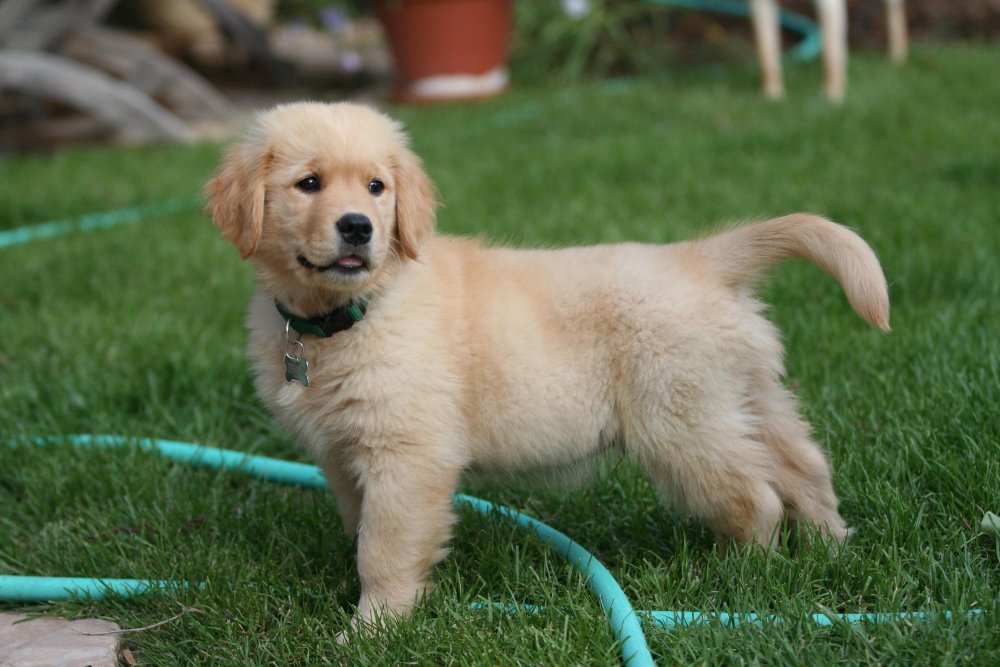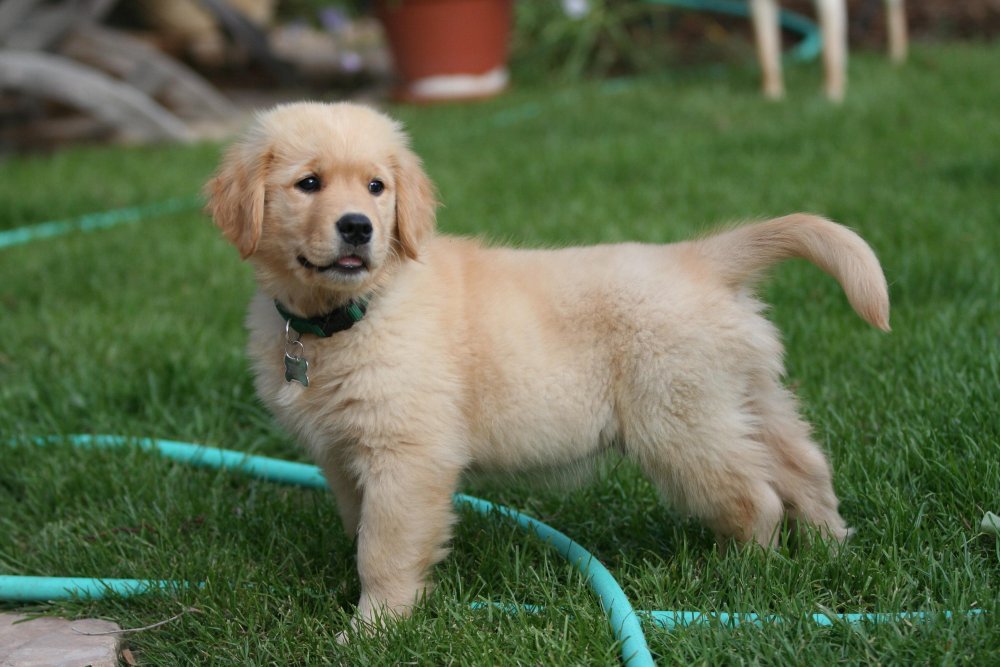- Breed Category: Sporting Group
- Country of Origin: Scotland
- Average Height: Male: 56-61 cm (22-24 in), Female: 51-56 cm (20-22 in)
- Average Weight: Male: 30-34 kg (66-75 lbs), Female: 25-30 kg (55-66 lbs)
- Average Life Span: 10-12 years
- Grooming Requirements: Regular brushing needed
- Exercise Requirements: High, daily exercise needed
- Coat Type: Dense, water-repellent
- Coat Color Variations: Golden, cream
- Shedding Level: High
- Ear Type: Floppy
- Tail Type: Long, feathered
- Temperament: Friendly, intelligent, devoted
- Intelligence Level: High
- Barking Tendency: Moderate
- Compatibility with Children: Excellent
- Compatibility with Other Pets: Very good
- Training Ease: Easy to train
- Common Health Issues: Hip dysplasia, heart issues
- Dietary Needs: Balanced diet, avoid overfeeding
- Energy Level: High
- Drooling Tendency: Moderate
- Sensitivity to Weather: Sensitive to heat
- Overall Maintenance Level: Moderate
- Original Purpose: Retrieving game
- Year of Recognition by Kennel Clubs: 1925
- Famous Breed Representatives: Buddy from “Air Bud”
- Apartment Friendly: Not ideal, needs space
- Best Suited For: Active families, outdoor enthusiasts
- Cost of Ownership: Moderate to high
- Unique Traits: Excellent swimmers, gentle mouth
- Cultural Significance: Popular in films and media
- Popularity Rank: Top 5 in Australia
Imagine a dog that’s not just a pet but a true companion, known for its friendly nature and intelligence. That’s the Golden Retriever for you. This breed is a favourite among families and individuals alike, thanks to its gentle temperament and eagerness to please. But there’s more to these dogs than just their golden coats and wagging tails.
Originating from Scotland in the late 19th century, Golden Retrievers were initially bred for retrieving game during hunting. Today, they’re cherished for their versatility, excelling in roles from guide dogs to therapy animals. In this article, we’ll dive into the characteristics that make Golden Retrievers unique, explore their rich history, and offer insights into their care and training.
History and Development of the Golden Retriever

Early Development of the Breed
The Golden Retriever’s journey began in the Scottish Highlands during the late 1800s. This breed was crafted with a purpose: to retrieve game from both water and land. The need for a dog that could handle the rugged terrain and unpredictable weather of Scotland led to the careful selection and breeding of the Golden Retriever. The breed’s development involved crossing the now-extinct Yellow Retriever with the Tweed Water Spaniel, along with some Bloodhound, Irish Setter, and more. This mix resulted in a dog with a keen sense of smell, a love for water, and a gentle mouth, perfect for retrieving game without damaging it.
Role in Hunting and Retrieving
Golden Retrievers quickly became indispensable to hunters. Their ability to retrieve game from both land and water made them a favourite among sportsmen. Their intelligence and trainability meant they could be taught to follow complex commands, making them reliable partners in the field. Even today, their retrieving instincts remain strong, and they excel in various dog sports and activities.
Key Historical Figures
One of the pivotal figures in the creation of the Golden Retriever was Dudley Marjoribanks, later known as Lord Tweedmouth. His meticulous breeding records from 1835 to 1890 provide a detailed account of the breed’s development. His vision and dedication laid the foundation for the Golden Retriever we know and love today.
Physical Characteristics of the Golden Retriever

Appearance
Golden Retrievers are medium to large-sized dogs, typically weighing between 25 to 34 kilograms. Their height ranges from 51 to 61 centimetres at the shoulder. The breed is renowned for its dense, water-repellent coat, which comes in various shades of gold, from light cream to rich, dark gold. This coat is not just beautiful but also functional, providing protection against the elements. Distinctive feathering on the chest, back of the legs, and tail adds to their elegant appearance.
Unique Physical Traits
One of the standout features of Golden Retrievers is their friendly expression, often described as a hallmark of the breed. Their eyes are dark and set well apart, giving them a kind and intelligent look. The ears are medium-sized and hang close to the cheeks, enhancing their gentle appearance. Their broad, strong muzzle and powerful neck contribute to their ability to retrieve game efficiently, while their muscular build supports their active lifestyle.
Temperament and Behaviour of the Golden Retriever

Typical Personality Traits
Golden Retrievers are known for their loyalty, intelligence, and friendliness. These dogs are eager to please, making them highly trainable and responsive to commands. Their intelligence is not just about learning tricks; it’s about understanding their human companions and adapting to different situations. Loyalty is at the heart of their nature, and they form strong bonds with their families.
Suitability as a Family Pet and Working Dog
As family pets, Golden Retrievers are hard to beat. Their gentle and patient nature makes them perfect for households with children. They thrive on companionship and are happiest when they’re part of family activities. Beyond being great pets, they excel as working dogs. Whether it’s guiding the visually impaired or providing comfort as therapy animals, their versatility is impressive.
Interaction with Children and Other Animals
Golden Retrievers are naturally good with children. Their playful yet gentle demeanour ensures they’re safe playmates. They’re also generally friendly with other animals, making them a good choice for multi-pet households. Their social nature means they enjoy the company of other dogs and can adapt well to various social settings.
Training and Exercise Needs of the Golden Retriever

Importance of Early Training and Socialisation
Golden Retrievers are eager learners, and starting their training early is key. Socialisation from a young age helps them grow into well-rounded adults. Exposing them to different environments, people, and other animals ensures they develop confidence and adaptability. This early groundwork is crucial for preventing behavioural issues down the line.
Recommended Training Techniques
Positive reinforcement is the way to go with Golden Retrievers. They respond well to praise, treats, and playtime as rewards. Consistency is important, so keep training sessions regular but short to maintain their interest. Incorporating fun activities like fetch or agility can make learning enjoyable for both you and your dog.
Daily Exercise Requirements and Activities They Enjoy
Golden Retrievers are active dogs that need plenty of exercise to stay healthy and happy. Aim for at least an hour of physical activity each day. They love activities like swimming, hiking, and playing fetch. These not only keep them fit but also satisfy their natural retrieving instincts. Regular exercise is essential to prevent boredom and the behavioural issues that can come with it.
Health and Lifespan of the Golden Retriever

Common Health Issues
Golden Retrievers are generally healthy, but like all breeds, they’re prone to certain health issues. Hip dysplasia, elbow dysplasia, and certain heart conditions are common. They can also be susceptible to eye disorders and skin allergies. Regular vet check-ups are crucial to catch any potential problems early.
Average Lifespan and Health Tips
The average lifespan of a Golden Retriever is around 10 to 12 years. To keep them healthy, a balanced diet and regular exercise are key. Maintaining a healthy weight can prevent joint issues and other health problems. Mental stimulation is just as important, so engage them with puzzles and interactive toys.
Preventative Care Recommendations
- Schedule regular vet visits for vaccinations and health screenings.
- Brush their teeth regularly to prevent dental issues.
- Keep their coat clean and groomed to avoid skin problems.
- Provide a balanced diet rich in nutrients.
- Ensure they get plenty of exercise to maintain a healthy weight.
Grooming and Maintenance of the Golden Retriever

Coat Care and Grooming Routines
Golden Retrievers boast a beautiful, dense coat that requires regular attention. A good brushing session two to three times a week helps keep their coat healthy and free from tangles. This routine not only maintains their appearance but also reduces the amount of hair around your home. A slicker brush and an undercoat rake are handy tools for this task. Regular grooming also provides an opportunity to check for any skin issues or parasites.
Shedding and Seasonal Grooming Tips
Golden Retrievers are known for shedding, especially during the change of seasons. During these times, daily brushing can help manage the extra hair. A deshedding tool can be particularly effective in removing loose undercoat hair. Bathing your Golden Retriever every couple of months, or as needed, keeps their coat clean and fresh. Always use a dog-friendly shampoo to avoid skin irritation. Regular grooming not only keeps your dog looking their best but also strengthens the bond between you and your furry friend.
Diet and Nutrition for Golden Retrievers

Nutritional Needs for Optimal Health
Golden Retrievers thrive on a balanced diet rich in proteins, healthy fats, and essential vitamins. Proteins support their muscular build, while fats provide the energy they need for their active lifestyle. Omega-3 and Omega-6 fatty acids are particularly beneficial for maintaining their lustrous coat and healthy skin. Don’t forget the importance of carbohydrates for energy and fibre for digestion.
Foods to Include and Avoid
Include high-quality dog food with real meat as the first ingredient. Fresh fruits and vegetables like carrots, apples, and spinach can be great additions. Avoid foods high in artificial preservatives, fillers, and by-products. Chocolate, grapes, and onions are toxic to dogs and should be kept out of reach.
Feeding Schedules and Portion Recommendations
Establish a consistent feeding schedule, typically twice a day for adult Golden Retrievers. Puppies may require more frequent meals. Portion sizes depend on their age, weight, and activity level, so consult your vet for tailored advice. Overfeeding can lead to obesity, so monitor their weight and adjust portions as needed.
Fun Facts and Trivia about Golden Retrievers

Interesting Tidbits about the Breed
Golden Retrievers are not just known for their good looks and friendly nature; they have some fascinating traits too. Did you know they have a “soft mouth”? This means they can carry delicate items, like raw eggs, without breaking them. It’s a skill that harks back to their hunting days. Another fun fact is their love for water. Thanks to their water-repellent coats and webbed feet, they are natural swimmers.
Famous Golden Retrievers in Media or History
Golden Retrievers have made their mark in the world of media and history. One of the most famous is Buddy, the dog who played Comet on the TV show “Full House.” Buddy’s charm and intelligence won the hearts of viewers worldwide. In history, a Golden Retriever named Liberty was a beloved companion of U.S. President Gerald Ford, often seen by his side during his presidency. These dogs have not only been loyal companions but have also become icons in their own right.
Final Thoughts
Golden Retrievers embody the perfect blend of intelligence and companionship. Their friendly nature and versatility make them ideal family pets and working dogs. While they require regular grooming and exercise, the rewards of their loyalty and affection are immeasurable. Embracing a Golden Retriever means welcoming a devoted friend into your life, ready to share in adventures and quiet moments alike. Consider adopting one of these remarkable dogs and experience the joy they bring to countless families worldwide.
